در مورد رم و ایتالیا چه می دانید.؟
صفحه ویکیپدیای انگلیسی را در این مورد در اینجا آورده ایم:
Rome
From Wikipedia, the free encyclopedia
For the civilisation of classical antiquity, see Ancient Rome. For other uses, see Rome (disambiguation).
| Rome Roma | |||
|---|---|---|---|
| — Comune — | |||
| Roma Capitale | |||
| A view of Rome: the top left picture to the is the Colosseum, followed (left to right) by the Monument to Vittorio Emanuele II, the Piazza della Repubblica, the Castel Sant' Angelo, the Trevi Fountain, the dome of St. Peter's Basilica and finally an aerial view of the city's historic centre. | |||
| |||
| Nickname(s): The Eternal City | |||
| | |||
| Coordinates: 41°54′N 12°30′E / 41.9°N 12.5°ECoordinates: 41°54′N 12°30′E / 41.9°N 12.5°E | |||
| Country | Italy | ||
| Region | Lazio | ||
| Province | Rome (RM) | ||
| Government | |||
| - Mayor | Gianni Alemanno (PdL) | ||
| Area | |||
| - Total | 1,285.31 km2 (496.3 sq mi) | ||
| Elevation | 20 m (66 ft) | ||
| Population (December 2009)[1] | |||
| - Total | 2,743,796 | ||
| - Density | 2,134.7/km2 (5,528.9/sq mi) | ||
| Demonym | Romani | ||
| Time zone | CET (UTC+1) | ||
| - Summer (DST) | CEST (UTC+2) | ||
| Postal code | 00100; 00121 to 00199 | ||
| Dialing code | 06 | ||
| Patron saint | Saint Peter and Saint Paul | ||
| Saint day | 29 June | ||
| Website | Official website | ||
The city of Rome is located in the central-western portion of the Italian Peninsula, on the Tiber River within the Lazio region of Italy. Rome's history spans over two and a half thousand years. It was the capital city of the Roman Kingdom, the Roman Republic and the Roman Empire, which was the dominant power in Western Europe and the lands bordering the Mediterranean Sea for over seven hundred years from the 1st Century BC until the 7th Century AD. Since the 2nd Century AD Rome has been the seat of the Papacy and, after the end of Byzantine domination, in the 8th century it became the capital of the Papal States, which lasted until 1870. In 1871 Rome became the capital of the Kingdom of Italy, and in 1946 that of the Italian Republic.
After the Middle-Ages, Rome was ruled by popes such as Alexander VI and Leo X, who transformed the city into one of the major centers of the Italian Renaissance, along with Florence.[3] The current-day version of St Peter's Basilica was built and the Sistine Chapel was painted by Michelangelo. Famous artists and architects, such as Bramante, Bernini and Raphael resided for some time in Rome, contributing to its Renaissance and Baroque architecture.
In 2007 Rome was the 11th-most-visited city in the world, 3rd most visited in the European Union, and the most popular tourist attraction in Italy.[4] The city is one of Europe's and the world's most successful city brands, both in terms of reputation and assets.[5] Its historic centre is listed by UNESCO as a World Heritage Site.[6] Monuments and museums such as the Vatican Museums and the Colosseum are amongst the world's 50 most visited tourist destinations (the Vatican Museums receiving 4.2 million tourists and the Colosseum receiving 4 million tourists every year).[7]
[edit] Etymology
About the origin of the name Roma several hypotheses have been advanced.[8] The most important are the following:- from Rommylos (Romulus), son of Ascanius and founder of the city;
- from Rumon or Rumen, archaic name of Tiber. It has the same root of the Greek verb ῥέω (rhèo) and of the Latin verb ruo, which both mean "flow";[9]
- from the Etruscan word ruma, whose root is *rum-, "teat", with possible reference either to the totem wolf that adopted and suckled the cognately named twins Romulus and Remus, or to the shape of Palatine and Aventine hills;
- from the Greek word ῤώμη (rhòme), which means strength;[10]
[edit] History
Main articles: History of Rome and Timeline of Rome history
[edit] Earliest history
Main article: Founding of Rome
There is archaeological evidence of human occupation of the Rome area from at least 14,000 years, but the dense layer of much younger debris obscures Palaeolithic and Neolithic sites.[11] Evidence of stone tools, pottery and stone weapons attest to at least 10,000 years of human presence. The power of the well known tale of Rome's legendary foundation tends also to deflect attention from its actual, and much more ancient, origins.[edit] Monarchy, Republic, Empire
Main articles: Ancient Rome, Roman Kingdom, Roman Republic, and Roman Empire
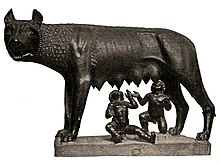
Capitoline Wolf suckles the infant twins Romulus and Remus.
The legendary origin of the city tells that Romulus and Remus decided to build a city. After an argument, Romulus killed his brother Remus. Archaeological evidence supports the view that Rome grew from pastoral settlements on the Palatine Hill built in the area of the future Roman Forum. While some archaeologists argue that Rome was indeed founded in the middle of the 8th century BC, the date is subject to controversy.[14] The original settlement developed into the capital of the Roman Kingdom (ruled by a succession of seven kings, according to tradition), and then the Roman Republic (from 510 BC, governed by the Senate), and finally the Roman Empire (from 27 BC, ruled by an Emperor). This success depended on military conquest, commercial predominance, as well as selective assimilation of neighbouring civilisations, most notably the Etruscans and Greeks. From its foundation Rome, although losing occasional battles, had been undefeated in war until 386 BC, when it was briefly occupied by the Gauls.[15] According to the legend, the Gauls offered to deliver Rome back to its people for a thousand pounds of gold, but the Romans refused, preferring to take back their city by force of arms rather than ever admitting defeat, after which the Romans recovered the city in the same year.
The Roman Republic was wealthy, powerful and stable before it became an empire. According to tradition, Rome became a republic in 509 BC. However, it took a few centuries for Rome to become the great city of popular imagination, and it only became a great empire after the rule of Augustus (Octavian). By the 3rd century BC, Rome had become the pre-eminent city of the Italian peninsula, having conquered and defeated the Sabines, the Etruscans, the Samnites and most of the Greek colonies in Sicily, Campania and Southern Italy in general. During the Punic Wars between Rome and the great Mediterranean empire of Carthage, Rome's stature increased further as it became the capital of an overseas empire for the first time. Beginning in the 2nd century BC, Rome went through a significant population expansion as Italian farmers, driven from their ancestral farmlands by the advent of massive, slave-operated farms called latifundia, flocked to the city in great numbers. The victory over Carthage in the First Punic WarSicily and Sardinia. Parts of Spain (Hispania) followed, and in the beginning of the 2nd century the Romans got involved in the affairs of the Greek world. By then all Hellenistic kingdoms and the Greek city-states were in decline, exhausted from endless civil wars and relying on mercenary troops. This saw the fall of Greece after the Battle of Corinth 146 BC and the establishment of Roman control over Greece.[16] brought the first two provinces outside the Italian peninsula,

The Roman Empire at its greatest extent
Roman dominance expanded over most of Western Europe and the shores of the Mediterranean Sea, though its influence through client states and the sheer power of its presence was wider than its formal borders. Its population surpassed one million inhabitants.[21]Western world. After the Empire started to decline and was split, it lost its capital status to Milan and then to Ravenna, and was surpassed in prestige by the capital of the Eastern Roman Empire, Constantinople, whose Greek inhabitants continued through the centuries to call themselves Roman. For almost a thousand years, Rome was the most politically important, richest, and largest city in the
[edit] Fall of the Western Empire and Middle Ages

15th century miniature depicting the Sack of Rome (410)
Rome remained the capital of the Papal States until its annexation by the Kingdom of Italy in 1870; the city became a major pilgrimage site during the Middle Ages and the focus of struggles between the Papacy and the Holy Roman Empire starting with Charlemagne, who was crowned its first emperor in Rome in 800 by Pope Leo III. Apart from brief periods as an independent city during the Middle Ages, Rome kept its status as Papal capital and "holy city" for centuries, even when the Papacy briefly relocated to Avignon (1309–1377).
[edit] Renaissance
Main articles: Roman Renaissance and 15th - 16th century Rome
The latter half of the 15th century saw the seat of the Italian Renaissance move to Rome from Florence. The Papacy wanted to equal and surpass the grandeur of other Italian cities and to this end created ever more extravagant churches, bridges, squares and public spaces, including a new Saint Peter's Basilica, the Sistine Chapel, Ponte Sisto (the first bridge to be built across the Tiber since antiquity), and Piazza Navona. The Popes were also patrons of the arts engaging such artists as Michelangelo, Perugino, Raphael, Ghirlandaio, Luca Signorelli, Botticelli, and Cosimo Rosselli.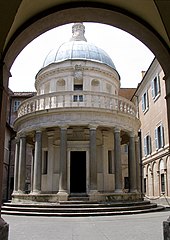
The Tempietto (San Pietro in Montorio), which is an excellent example of Italian Renaissancearchitecture
The Italian Renaissance in Rome more or less began when the end of the French captivity came in 1377, and the return of the papacy to Rome.[citation needed] Pope Martin V (1417–1431), planned to renew the Roman Catholic Church, and pursue new spiritual and political reforms. Martin V and his successors began to follow these new instructions, and Pope Nicholas VRenaissance-style urban re-development of the city.[citation needed] (1447–1455) really began to plan out much of the
The Renaissance period changed Rome's face dramatically, with works like the Pietà by Michelangelo and the frescoes of the Borgia Apartment, all made during Innocent's reign. Rome reached the highest point of splendour under Pope Julius II (1503–1513) and his successors Leo X and Clement VII, both members of the Medici family. In this twenty-years period Rome became one of the greatest centres of art in the world. The old St. Peter's Basilica built by Emperor Constantine the Great[24] (which by then was in a terrible state) was demolished and a new one begun. The city hosted artists like Ghirlandaio, Perugino, Botticelli and Bramante, who built the temple of San Pietro in Montorio and planned a great project to renovate the Vatican. Raphael, who in Rome became one the most famous painters of Italy creating frescos in the Cappella Niccolina, the Villa Farnesina, the Raphael's Rooms, plus many other famous paintings. Michelangelo started the decoration of the ceiling of the Sistine Chapel and executed the famous statue of the Moses for the tomb of Julius. Rome lost in part its religious character, becoming increasingly a true Renaissance city, with a great number of popular feasts, horse races, parties, intrigues and licentious episodes. Its economy was rich, with the presence of several Tuscan bankers, including Agostino Chigi, who was a friend of Raphael and a patron of arts. Before his early death, Raphael also promoted for the first time the preservation of the ancient ruins. The fight between France and Spain in Europe caused the first plunder of the City in more than one thousand years. In 1527 the Landsknechts of Emperor Charles V sacked the city, putting to an abrupt end the golden age of the renaissance in Rome.[25]
[edit] Counter-Reformation and Baroque
In the beginning of the 16th century the Church began also a secular struggle against the Reformation, which subtracted a great part of Christendom to the papal authority.[25] The revenge of the church started with the Council of Trent, and with the great Popes of the Counter-Reformation (from Pius IV to Sixtus V). Under them Rome became the center of the reformed Catholicism, and thanks to them the City was adorned with monuments which celebrated the restored greatness of the Papacy.[26] During the 17th and the beginning of the 18th centuries the Popes continued the tradition of Counter-reformation, enriching the city's landscape with Baroque buildings, erected by the Popes themselves or by theirs Cardinal-nephews.[25] During the Age of Enlightenment the new ideas reached also the Eternal City, where the Papacy supported Archeological Studies and improved the people's welfare.[25] However, at the same time the Popes had to fight against the anti-church policy of the great European powers which, among others, forced them to suppress the Jesuits.[25][edit] Towards the reunification of Italy

Giuseppe Garibaldi defends Rome against the French in 1849.
In 1849, another Roman Republic arose within the framework of revolutions of 1848. Two of the most influential figures of the Italian unification, Giuseppe Mazzini and Giuseppe Garibaldi, fought for the short-lived republic.
Rome became the focus of hopes of Italian reunification when the rest of Italy was reunited under the Kingdom of Italy with a temporary capital at Florence. In 1861, Rome was declared the capital of Italy even though it was still under the control of the Pope. During the 1860s, the last vestiges of the Papal States were under the French protection Napoleon III. And it was only when this was lifted in 1870, owing to the outbreak of the Franco-Prussian War, that Italian troops were able to capture Rome entering the city through a breach near Porta Pia. Afterwards, Pope Pius IX declared himself as prisoner in the Vatican, and in 1871 the capital of Italy was moved from Florence to Rome.[27]
[edit] 20th and 21st centuries
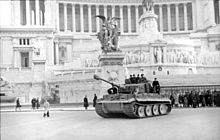
German troops occupying Rome in 1944
Rome grew momentously after the war, as one of the driving forces behind the "Italian economic miracle" of post-war reconstruction and modernisation. It became a fashionable city in the 1950s and early 1960s, the years of "la dolce vita" ("the sweet life"), with popular classic fims such as Ben Hur, Quo Vadis, Roman Holiday and La Dolce Vita.[28] being filmed in the city's iconic Cinecittà Studios. A new rising trend in population continued until the mid-1980s, when the commune had more than 2,800,000 residents; after that, population started to slowly decline as more residents moved to nearby suburbs.

Logo of the 1960 Summer Olympics
Many of the monuments of Rome were restored by the Italian state and by the Vatican for the 2000 Jubilee.
Being the capital city of Italy, Rome hosts all the principal institutions of the nation, like the Presidency of the Republic, the government (and its single Ministeri), the Parliament, the main judicial Courts, and the diplomatic representatives of all the countries for the states of Italy and the Vatican City (curiously, Rome also hosts, in the Italian part of its territory, the Embassy of Italy for the Vatican City, a unique case of an Embassy within the boundaries of its own country). Many international institutions are located in Rome, notably cultural and scientific ones – such as the American Institute, the British School, the French Academy, the Scandinavian Institutes, the German Archaeological Institute – for the honour of scholarship in the Eternal City, and humanitarian ones, such as the FAO. Rome, also hosts major international and worldwide political and cultural organisations, such as the International Fund for Agricultural DevelopmentWorld Food Programme (WFT), the NATO Defence College and ICCROM, the International Center for the Study of the Preservation and Restoration of Cultural Property [1]. (IFAD),

The official logo of the Great 2000 Jubilee features its motto: Christ Yesterday, Today, Forever.
Rome today is one of the most important tourist destinations of the world, due to the incalculable immensity of its archaeological and artistic treasures, as well as for the charm of its unique traditions, the beauty of its panoramic views, and the majesty of its magnificent "villas" (parks). Among the most significant resources are the many museums – (Musei Capitolini, the Vatican Museums, Galleria Borghese, including those dedicated to modern and contemporary art and great many others) — aqueducts, fountains, churches, palaces, historical buildings, the monuments and ruins of the Roman Forum, and the Catacombs.
Rome has a growing stock of contemporary and modern art and architecture. The National Gallery of Modern Art has works by Balla, Morandi, Pirandello, Carrà, De Chirico, De Pisis, Guttuso, Fontana, Burri, Mastroianni, Turcato, Kandisky, Cézanne on permanent exhibition. 2010 sees the opening of Rome's newest arts foundation, a contemporary art and architecture gallery designed by acclaimed Iraqi architect Zaha Hadid. Known as Maxxi National Museum of XXIst century Art and Architecture it restores a dilapidated area with striking modern architecture. Maxxi [32] features a campus dedicated to culture, experimental research laboratories, international exchange and study and research. It is one of Rome's most ambitious modern architecture projects alongside Renzo Piano's Auditorium Parco della Musica [33] and Massimiliano Fuksas' Rome Convention Center, Centro Congressi Italia EUR, in the EUR district, due to open in 2011.[34] The Convention Center features a huge translucent container inside which is suspended a steel and teflon structure resembling a cloud and which contains meeting rooms and an auditorium with two piazzas open to the neighbourhood on either side.
Rome is the 3rd most visited city in the EU, after London and Paris, and receives an average of 7–10 million tourists a year, which sometimes doubles on holy years. The Colosseum (4 million tourists) and the Vatican Museums (4.2 million tourists) are the 39th and 37th (respectively) most visited places in the world, according to a recent study.[35]
Among its hundreds of churches, Rome contains the only four Major Basilicas of the Catholic Church: San Giovanni in Laterano, Rome's cathedral, San Pietro in Vaticano, San Paolo fuori le Mura, and Santa Maria Maggiore. Along with the minor basilica of San Lorenzo fuori le Mura, those churches are the five Patriarchal Basilicas of the Pentarchy. finally, the five Basilicas, along with the two churches of Santa Croce in Gerusalemme and San Sebastiano fuori le Mura, constitute the Seven Pilgrim Churches of Rome.
The Bishop of Rome is the Pope.
[edit] Administration
See also: List of mayors of Rome
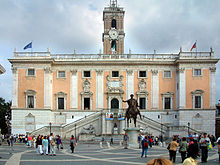
Palazzo Senatorio, Rome City Hall
[edit] Capital of Italy
Rome is the national capital of Italy and is the seat of the Italian Government. The official residences of the President of the Italian Republic and the Italian Prime Minister, the seats of both houses of the Italian Parliament and that of the Italian Constitutional Court are located in the historic centre. The state ministries are spread out around the city; these include the Ministry of Foreign Affairs, which is located in Palazzo della Farnesina near the Olympic stadium.[edit] City government
Rome constitutes one of Italy's 8,101 communes, and is the largest both in terms of land area and population. It is governed by a mayor, currently Gianni Alemanno, and a city council. The seat of the commune is the Palazzo Senatorio on the Capitoline Hill, the historic seat of the city government. The local administration in Rome is commonly referred to as "Campidoglio", the Italian name of the hill.[edit] Administrative divisions
Main article: Administrative subdivision of Rome
Rome is divided into 20 administrative areas, called municipi or municipalities. They were created in 1972 for administrative reasons to increase decentralisation in the city.[36] Each municipality is governed by a president and a council of four members who are elected by the residents of the municipality every five years. The municipalities frequently cross the boundaries of the traditional, non-administrative divisions of the city.[edit] Rioni of Rome
Main article: Rioni of Rome
See also: 14 regions of Augustan Rome and 14 regions of Medieval Rome
Rome is also divided into differing types of non-administrative divisions. The historic centre is divided into 22 rioni, all of which are located within the Aurelian Walls except Prati and Borgo.The Rioni have changed in number throughout history, from ancient Rome, the medieval[37] to the Renaissance. They were later organized in a more precise way by Pope Benedict XIV in 1743. period,
Even after Napoleon I lost his power in the city, there were no sensible changes in the organisation of the city, until Rome became the capital of the new born Italy. The needs of the new capital caused a great urbanisation and an increase of the population, both within the Aurelian walls and outside them. In 1874 the rioni became 15 adding Esquilino, obtained taking a part from Monti. At the beginning of the 20th century some rioni started being split up and the first parts outside the Aurelian walls started being considered part of the city.
In 1921 the number of the rioni increased to 22. Prati was the last rione to be established. and the only one outside the City Walls.
With the creation of the circoscrizioni (later renamed municipi) in 1972, all the rioni, except Borgo and Prati, have been placed in the first one, Municipio I, which so contains almost completely the Centro Storico.
The complete list of the modern rioni, in order of number, is the following:
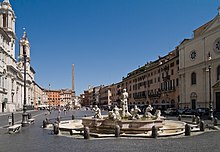
Piazza Navona, part of Parione.[38]
- Monti
- Trevi
- Colonna
- Campo Marzio
- Ponte
- Parione
- Regola
- Sant'Eustachio
- Pigna
- Campitelli
- Sant'Angelo
- Ripa
- Trastevere
- Borgo
- Esquilino
- Ludovisi
- Sallustiano
- Castro Pretorio
- Celio
- Testaccio
- San Saba
- Prati
[edit] Geography
[edit] Location
Rome is in the Lazio region of central Italy on the Tiber river (Italian: Tevere). The original settlement developed on hills that faced onto a ford beside the Tiber island, the only natural ford of the river in this area. The Rome of the Kings was built on seven hills: the Aventine Hill, the Caelian Hill, the Capitoline Hill, the Esquiline Hill, the Palatine Hill, the Quirinal Hill, and the Viminal Hill. Modern Rome is also crossed by another river the Aniene which joins the Tiber north of the historic centre.Although the city center is about 24 kilometres (15 mi) inland from the Tyrrhenian Sea, the city territory extends to the shore, where the south-western district of Ostia is located. The altitude of the central part of Rome ranges from 13 metres (43 ft) above sea level (at the base of the Pantheon) to 139 metres (456 ft) above sea level (the peak of Monte Mario).[39] The Commune of Rome covers an overall area of about 1,285 square kilometres (496 sq mi), including many green areas.
[edit] Topography
Throughout the history of Rome, the urban limits of the city were considered to be the area within the city walls. Originally, these consisted of the Servian Wall, which was built twelve years after the Gaulish sack of the city in 390 BC. This contained most of the Esquiline and Caelian hills, as well as the whole of the other five. Rome outgrew the Servian Wall, but no more walls were constructed until almost 700 years later, when, in 270 AD, Emperor Aurelian began building the Aurelian Walls. These were almost 19 kilometres (12 mi) long, and were still the walls the troops of the Kingdom of Italy had to breach to enter the city in 1870. Modern Romans frequently consider the city's urban area to be delimited by its ring-road, the Grande Raccordo Anulare, which circles the city centre at a distance of about 10 km.The Commune of Rome, however, covers considerably more territory and extends to the sea at Ostia, the largest town in Italy that is not a commune in its own right. The Commune covers an area roughly three times the total area within the Raccordo and is comparable in area to the entire provinces of Milan and Naples, and to an area six times the size of the territory of these cities. It also includes considerable areas of abandoned marsh land which is suitable neither for agriculture nor for urban development.
As a consequence, the density of the Commune is not that high, the communal territory being divided between highly urbanised areas and areas designated as parks, nature reserves, and for agricultural use. The Province of Rome is the largest by area in Italy. At 5,352 square kilometres (2,066 sq mi), its dimensions are comparable to the region of Liguria.
[edit] Climate
Rome enjoys a Mediterranean climate (Köppen climate classification: Csa),[40] typical of the Mediterranean coasts of Italy. Spring and autumn are mild to warm, and the Romans ottobrate[41] the first since 1986 (in some peripheral areas since 1991); between 1986 and 2010 snow fell four times, without significant traces on the ground. ("beautiful October days") are known as being sunny and warm. By August, the maximum diurnal temperature often exceeds 30 °C (86 °F). Traditionally, many businesses were accustomed to closing during August, while Romans visited holiday resorts. In more recent years, however, in response to growing tourism and changing work habits, the city has been staying open for the whole summer. The average high temperature in January is about 12.9 °C (55.2 °F), but in hot periods it can be higher, while subzero lows are not uncommon. Snowfalls can occur in December, January and February. Within the last four decades they have been rare in Rome: the most recent snowfall with accumulation was in February 2010,Generally – summer's season lasts about 6 months, from May to October. Two months (April and November) are transitional, sometimes there are temperature above 20 °C (68 °F). December, January, February and March is the coldest months, with average temperatures (of these four months) over 13.1 °C (55.6 °F) near city centre (13.9 °C (57.0 °F) near sea) during the day and 3.7 °C (38.7 °F) near city centre (4.7 °C (40.5 °F) near sea) at night. Average relative humidity is 74.8%, from 72% in July to 77% in November and December.
| [hide]Climate data for Rome-Ciampino airport, near city centre (1961–1990) | |||||||||||||
|---|---|---|---|---|---|---|---|---|---|---|---|---|---|
| Month | Jan | Feb | Mar | Apr | May | Jun | Jul | Aug | Sep | Oct | Nov | Dec | Year |
| Average high °C (°F) | 11.8 (53.2) | 13.0 (55.4) | 15.2 (59.4) | 18.1 (64.6) | 22.9 (73.2) | 27.0 (80.6) | 30.4 (86.7) | 30.3 (86.5) | 26.8 (80.2) | 21.8 (71.2) | 16.3 (61.3) | 12.6 (54.7) | 20.5 (68.9) |
| Daily mean °C (°F) | 7.3 (45.1) | 8.3 (46.9) | 10.1 (50.2) | 12.8 (55) | 17.0 (62.6) | 20.9 (69.6) | 23.9 (75) | 23.9 (75) | 20.8 (69.4) | 16.3 (61.3) | 11.6 (52.9) | 8.3 (46.9) | 15.3 (59.5) |
| Average low °C (°F) | 2.7 (36.9) | 3.5 (38.3) | 5.0 (41) | 7.5 (45.5) | 11.1 (52) | 14.7 (58.5) | 17.4 (63.3) | 17.5 (63.5) | 14.8 (58.6) | 10.8 (51.4) | 6.8 (44.2) | 3.9 (39) | 10.0 (50) |
| Precipitation mm (inches) | 102.6 (4.039) | 98.5 (3.878) | 67.5 (2.657) | 65.4 (2.575) | 48.2 (1.898) | 34.4 (1.354) | 22.9 (0.902) | 32.8 (1.291) | 68.1 (2.681) | 93.7 (3.689) | 129.6 (5.102) | 111.0 (4.37) | 874.7 (34.437) |
| Avg. precipitation days | 9.0 | 8.8 | 8.7 | 8.7 | 5.8 | 4.4 | 2.2 | 3.2 | 5.6 | 7.6 | 10.9 | 9.6 | 84.5 |
| Sunshine hours | 120.9 | 132.8 | 167.4 | 201.0 | 263.5 | 285.0 | 331.7 | 297.6 | 237.0 | 195.3 | 129.0 | 111.6 | 2,472.8 |
| Source: Italiano della Meteorologia[42] | |||||||||||||
| [show]Climate data for Rome-Fiumicino airport, near sea (1961–1990) |
|---|
[edit] Demographics

St. Peter's Basilica from the River Tiber. The iconic dome dominates the skyline of Rome
Almost the entire population of Rome speaks Romanesco (mostly a dialect of Italian language) in the daily life and in informal situations, but allegedly everyone can also speak Standard Italian which is therefore used in more formal situations.
|
|
|

The Via Napoleone III, the main street in the "Rome Chinatown", one of the most significant areas of Chinese immigration in Italy along with the Milan Chinatown and Prato Chinatown.
[edit] Ethnic groups
According to the latest Caritas annual report, on the 1st January 2008, roughly 10% of the population of Rome was not Italian. The largest ethnic minority groups come from other European countries (mostly from Romania) from North Africa, (mostly Morocco, Algeria, and Egypt), which counts not less than 100,000 residents in Rome), East Asia (mostly Filipino) and the Americas (mostly from Argentina): 1.09%.The Esquilino district, off Termini Railway Station, has evolved into a largely immigrant neighbourhood, it is now seen as Rome's Chinatown, but in fact immigrants from more than a hundred different countries crowd its busy streets and piazzas. A thriving commercial district, Esquilino boasts dozens of restaurants featuring every kind of international cuisine. There are innumerable wholesale clothes shops: of the 1,300 or so commercial premises operating in the district 800 are Chinese-owned, around 300 are run by immigrants from other countries around the world and some 200 are owned by Italians.[45]
In order to serve the growing number Muslims community, in 1995 was inaugurated the first Mosque in Rome, which is as well the largest mosque in Europe.
[edit] Religion
Main article: Religion in Rome
See also: Religion in ancient Rome, Churches of Rome, Roman Curia, Roman Catholicism in Rome, and Archdiocese of Rome

St. Peter's Square in the Vatican City

The Basilica di Santa Maria Maggiore interior. It is one of the most important churches in the city.

Basilica of St. John Lateran, the cathedral of Rome
The territory includes Saint Peter's Square, separated from the territory of Italy only by a white line along the limit of the square, where it touches Piazza Pio XII. St. Peter's Square is reached through the Via della Conciliazione, which runs from the Tiber River to St. Peter's. This grand approach was constructed by Benito Mussolini after the conclusion of the Lateran Treaty. According to the Lateran Treaty, certain properties of the Holy See that are located in Italian territory, most notably Castel Gandolfo and the major basilicas, enjoy extraterritorial status similar to that of foreign embassies.
In recent years, there has been a significant growth in Rome's Muslim community, mainly due to immigration from North African and Middle Eastern countries into the city. As a consequence of this increase of the local practitioners of the Islamic faith, the commune promoted the building of the largest mosque in Europe, which was designed by architect Paolo Portoghesi and inaugurated on June 21, 1995. Since the end of the Roman Republic Rome is also the center of an important Jewish community,[46] which was once based in Trastevere, and later in the Roman Ghetto. There lies also the major synagogue in Rome, the Tempio Maggiore.
[edit] Main sights
See also: List of tourist attractions in Rome and List of streets in Rome
The Colosseum and the Arch of Constantine
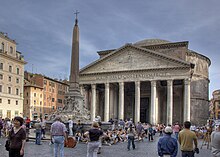
The Pantheon

The Quirinal Palace.

The Roman Forum with the Capitoline Hill behind.
[edit] Architecture
Main article: Architecture of Rome
[edit] Ancient Rome
Main articles: List of ancient monuments in Rome and Ancient Roman architecture
One of the symbols of Rome is the Colosseum (70–80 AD), the largest amphitheatre ever built in the Roman Empire. Originally capable of seating 60,000 spectators, it was used for gladiatorial combat. A list of important monuments and sites of ancient Rome includes the Roman Forum, the Domus Aurea, the Pantheon, Trajan's Column, Trajan's Market, the Catacombs, the Circus Maximus, the Baths of Caracalla, Castel Sant'Angelo, the Mausoleum of Augustus, the Ara Pacis, the Arch of Constantine, the Pyramid of Cestius, and the Bocca della Verità.[edit] Medieval
Often overlooked, Rome's medieval heritage is one of the largest in Italian cities. Basilicas dating from the Paleochristian age include Santa Maria Maggiore and San Paolo Fuori le MuraSanta Maria in Trastevere, Santi Quattro Coronati, and Santa Prassede. Lay buildings include a number of towers, the largest being the Torre delle Milizie and the Torre dei Conti, both next the Roman Forum, and the huge staircase leading to the basilica of Santa Maria in Ara Coeli. (the latter largely rebuilt in the 19th century), both housing precious 4th century AD mosaics. Later notable medieval mosaic and fresco art can be also found in the churches of[edit] Renaissance and Baroque
Rome was a major world centre of the Renaissance, second only to Florence, and was profoundly affected by the movement. Among others, a masterpiece of Renaissance architecture in Rome is the Piazza del Campidoglio by Michelangelo. During this period, the great aristocratic families of Rome used to build opulent dwellings as the Palazzo del QuirinalePresident of the Italian Republic), the Palazzo Venezia, the Palazzo Farnese, the Palazzo Barberini, the Palazzo Chigi (now seat of the Italian Prime Minister), the Palazzo Spada, the Palazzo della Cancelleria, and the Villa Farnesina. (now seat of theMany of the famous city's squares - some huge, majestic and often adorned with obelisks, some small and pictoresque - got their present shape during the Renaissance and Baroque. The principal ones are Piazza Navona, Piazza di Spagna, Campo de' Fiori, Piazza Venezia, Piazza Farnese, Piazza della Rotonda and Piazza della Minerva. One of the most emblematic examples of Baroque art is the Fontana di Trevi by Nicola Salvi. Other notable 17th-century baroque palaces are the Palazzo Madama, now the seat of the Italian Senate and the Palazzo Montecitorio, now the seat of the Chamber of Deputies of Italy.
[edit] Neoclassicism

The neoclassical Piazza del Popolo.
[edit] Fascist architecture
See also: Fascist architecture
The Fascist regime that ruled in Italy between 1922 and 1943 developed an architectural style that was characterised by its links with ancient Roman architecture. The most important Fascist site in Rome is the E.U.R district, designed in 1938 by Marcello Piacentini. It was originally conceived for the 1942 world exhibition, and was called "E.42" ("Esposizione 42"). The world exhibition, however, never took place because Italy entered the Second World War in 1940. The most representative building of the Fascist style at E.U.R. is the Palazzo della Civiltà ItalianaLondon Docklands and La Défense in Paris). Also the Palazzo della Farnesina, the current seat of Italian Foreign Ministry, was designed in 1935 in Fascist style. (1938–1943), the iconic design of which has been labelled the cubic or Square Colosseum. After World War II, the Roman authorities found that they already had the seed of an off-centre business district of the type that other capitals were still planning ([edit] Parks and gardens
Main article: List of parks and gardens in Rome
Public parks and nature reserves cover a large area in Rome, and the city has one of the largest areas of green space amongst European capitals.[47] The most notable part of this green space is represented by the large number of villas and landscaped gardens created by the Italian aristocracy. While many villas were destroyed during the building boom of the late 19th century, a great many remain. The most notable of these are Villa Borghese, Villa Ada, and Villa Doria Pamphili. Villa Doria Pamphili is west of the Gianicolo hill comprising some 1.8 km2. Also on the Gianicolo hill there is Villa Sciarra, with playgrounds for children and shaded walking areas. In the nearby area of Trastevere the Orto Botanico (Botanical Garden) is a cool and shady green space. The old Roman hippodrome (Circus Maximus) is another large green space but the main attraction is the ancient site of the chariot racing and it has few trees. Nearby is the lush Villa Celimontana, close to the gardens surrounding the Baths of Caracalla and Rose Garden (‘roseto comunale’). The Villa Borghese garden is the best known large green space in Rome, with famous art galleries among its shaded walks. It is close to the Spanish Steps and Piazza del Popolo. Rome also has a number of regional parks of much more recent origin including the Pineto Regional Park and the Appian Way Regional Park. There are also nature reserves at Marcigliana and at Tenuta di Castelporziano.[edit] Fountains and aqueducts
Main articles: List of fountains in Rome and List of aqueducts in the city of Rome

The Trevi Fountain
[edit] Statues
Main article: Talking statues of Rome
[edit] Obelisks and columns
Main article: List of obelisks in Rome
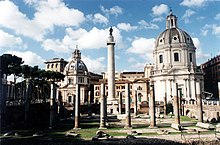
The column of Trajan, or in Italian "Colonna Traiana", an ancient Roman column in the city.

The Solare obelisk, in Piazza Montecitorio
[edit] Bridges
Main article: List of bridges in Rome
The city of Rome contains numerous famous bridges which cross the Tiber. Famous ones include the Ponte Cestio, the Ponte Milvio, the Ponte Nomentano, the Ponte Sant'Angelo, the Ponte Vittorio Emanuele II, the Ponte Sisto and the Ponte dei Quattro Capi. Currently there are five ancient Roman bridges still remaining in the city.[51] Most of the city's public bridges were built in Classical or Renaissance style, but also in Baroque, Neoclassical and Modern styles. According to the Encyclopædia Britannica, the finest ancient bridge remaining in Rome is the Ponte Sant'Angelo, which was completed in 135AD, and was decorated with 10 statues of the angels, designed by Bernini in 1688.[52]
Bridge of Angels which leads to Castel Sant'Angelo.
[edit] Catacombs
Main article: Catacombs of Rome
Rome has extensive amount of ancient catacombs, or underground burial places under or near the city, of which there are at least forty, some discovered only in recent decades. Though most famous for Christian burials, they include pagan and Jewish burials, either in separate catacombs or mixed together. The first large-scale catacombs were excavated from the 2nd century onwards. Originally they were carved through tuff, a soft volcanic rock, outside the boundaries of the city, because Roman law forbade burial places within city limits. Currently maintenance of the catacombs is in the hands of the Papacy which has invested in the Salesians of Don Bosco the supervision of the Catacombs of St. Callixtus on the outskirts of Rome.[edit] Economy
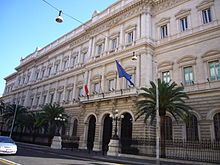
The Banca d'Italia (Bank of Italy) in Via Nazionale, Rome.
Main article: Economy of Rome
With a 2005 GDP of €94.376 billion (US$121.5 billion),[53] the city produces 6.7% of the national GDP (more than any other single city in Italy), and its unemployment rate, lowered from 11.1% to 6.5% between 2001 and 2005, is now one of the lowest rates of all the European Union capital cities.[53] Rome grows +4.4% annually and continues to grow at a higher rate in comparison to any other city in the rest of the country.[53] This means that were Rome a country, it would be the world's 52nd richest country by GDP, near to the size to that of Egypt. Rome also had a 2003 GDP per capita of €29,153 (US$ 37,412), which was second in Italy, (after Milan), and is more than 134.1% of the EU average GDP per capita.[54] Rome, on the whole, has the highest total earnings in Italy, reaching €47,076,890,463 in 2008,[55] yet, in terms of average workers' incomes, the city places itself 9th in Italy, with €24,509, coming after Treviso (€24,593) and Siena (€24,549), and surpassing Parma (€24,456) and Varese (€24,045).[55] On a global level, Rome's workers receive the 30th highest wages in 2009, coming three places higher than in 2008, in which the city was 33rd. This means that, whilst gross average earnings are less than Madrid and Barcelona, they are more than some other cities, such as Athens, Lisbon, DubaiHong Kong.[56] and Although the economy of Rome is characterised by the absence of heavy industry and it is largely dominated by services, high-technology companies (IT, aerospace, defence, telecommunications), research, construction and commercial activities (especially banking), and the huge development of tourism are very dynamic and extremely important to its economy. Rome's international airport, Fiumicino, is the largest in Italy, and the city hosts the head offices of the vast majority of the major Italian companies, as well as the headquarters of three of the world's 100 largest companies: Enel, Eni, and Telecom Italia.[57]
Universities, national radio and television and the movie industry in Rome are also important parts of the economy: Rome is also the hub of the Italian film industry, thanks to the CinecittàEsposizione Universale RomaTorrino (further south from the EUR); the Magliana; the Parco de' Medici-LaurentinaTiburtina-valley along the ancient Via Tiburtina. studios, working since the 1930s. The city is also a centre for banking and insurance as well as electronics, energy, transport, and aerospace industries. Numerous international companies and agencies headquarters, government ministries, conference centres, sports venues, and museums are located in Rome's principal business districts: the (EUR); the and the so-called
[edit] Tourism

The Spanish Steps, one of the city's iconic tourist attractions.
Main article: Tourism in Rome
Tourism is Rome's chief industry, with numerous notable museums including the Vatican Museum, the Borghese Gallery, and the Musei Capitolini: in 2005 the city registered 19.5 million visitors, up of 22.1% from 2001.[53] In 2006 Rome was visited by 6.03 million international tourists, reaching the 8th place in the ranking of the world's 150 most visited cities.[58] Rome is also the third most visited city in the EU,[4] and its historic centre, along with "the Properties of the Holy See in that City Enjoying Extraterritorial Rights and San Paolo Fuori le Mura," is listed by UNESCO as a World Heritage Site.[6] The World Heritage site was extended in 1990 to the walls of Urban VIII, to include the Forums, the Mausoleum of Augustus, the Mausoleum of Hadrian, the Pantheon, Trajan’s Column and the Column of Marcus Aurelius, as well as the religious and public buildings of papal Rome.The city's international branding has proved to be successful; in terms of marketing, the city ranks ninth worldwide, yet in terms of attractions and touristic assets, it ranks sixth. According to one study, Rome has several touristic sights, monuments and an attractive atmosphere which makes it one of the top cities cities in terms of branding. Its communication is less effective than other cities such as Berlin, but it remains in the top ten most commercially successful cities.[5]
Public monuments and buildings, such as the Vatican Museums and the Colosseum are amongst the world's 50 most visited tourist destinations (the Vatican Museums receiving 4.2 million tourists and the Colosseum receiving 4 million tourists every year).[7]
[edit] Education
Rome is a nation-wide and major international centre for higher education, containing numerous academies, colleges and universities. According to the City Brands Index, Rome is considered the world's second most historically, educationally and culturally interesting and beautiful city.[59]Ancient Rome and the Renaissance, along with Florence.[60] It boasts a large variety of academies and colleges, and has always been a major worldwide intellectual and educational centre, especially during[edit] Libraries

The interior of the Biblioteca Casanatense.
[edit] Universities
See also: Roman academies

The Galleria Doria Pamphilj, one of the city's several art galleries.

The Gallery of Maps in the Vatican Museums, the most visited in the city.
- Public and state universities:
- Sapienza University of Rome, also known as Roma 1 (Rome 1);
- University of Rome Tor Vergata, also known as Roma 2 (Rome 2);
- Roma Tre University;
- Istituto Universitario di Scienze Motorie.
- Private universities:
- Libera Università Internazionale degli Studi Sociali Guido Carli;
- Università Cattolica del Sacro Cuore (which is based in Milan, but has faculties in Rome);[66]
- Università Campus Bio-Medico;
- Università Europea di Roma;
- John Cabot University, a private American university in Rome;
- Libera università Maria SS. Assunta;
- Leonardo da Vinci Libera Università di Roma;
- S. Pio V University of Rome;
- Università UPTER, a folk high school;
- Università I.S.S.A.S.;
- Università degli studi "Guglielmo Marconi";
- Touro University Rome;
- Pontifical colleges, academies and universities are:
- Marianum (Pontifical Institute for the study of Mariology);
- Pontifical Biblical Institute;
- Pontifical Ecclesiastical Academy;
- Pontifical Oriental Institute;
- Pontifical University of St. Anthony;
- Pontifical University of St. Bonaventure;
- Pontifical University of St. Thomas Aquinas (Angelicum);
- Pontifical University of the Holy Cross;
- Pontifical Athenaeum Regina Apostolorum;
- Pontifical Urbaniana University;
- Pontifical Gregorian University;
- Pontifical Lateran University;
- Salesian Pontifical University;
- Pontifical Institute of Spirituality Teresianum;
- Pontifical John Paul II Institute for Studies on Marriage and Family – while not a university per se, the Institute's several sessions throughout the world offer the licentiate and doctorate of sacred theology in the concentration of marriage and family. The Roman session is located at the Pontifical Lateran University.
- Pontifical University of St. Anselm;
- The Accademia Nazionale di Santa Cecilia, one of the oldest music institutions in the world (founded in 1584).
- The Accademia di Belle Arti di Roma or the Fine Arts Academy of Rome
- The Accademia di San Luca
[edit] Other institutions and foreign schools

The exterior of the Pontifical Gregorian University.
The Roman Colleges are several seminaries for students from foreign countries studying for the priesthood at the Pontifical Universities.[67] Examples include the Venerable English College, the Pontifical North American College, the Scots College, and the Pontifical Croatian College of St. Jerome.
[edit] Museums and art galleries
Main article: List of museums in Rome

The interior of the Capitoline Museums
[edit] Culture
Main articles: Culture in Rome, Events in Rome, and List of people from Rome
| Historic Centre of Rome, the Properties of the Holy See in that City Enjoying Extraterritorial Rights and San Paolo Fuori le Mura* | |
|---|---|
| UNESCO World Heritage Site | |
 | |
| Type | Cultural |
| Criteria | i, ii, iii, iv, vi |
| Reference | 91 |
| Region** | Europe and North America |
| Inscription history | |
| Inscription | 1980 (4th Session) |
| Extensions | 1990 |
| * Name as inscribed on World Heritage List. ** Region as classified by UNESCO. | |

Michelangelo's Last JudgmentSistine Chapel fresco in the
[edit] Archaeology

The Roman Forum
Main article: Roman archaeology
Rome is a major archaeological hub, and one of the world's main centres of archaeological research. There are numerous cultural and research institutes located in the city, such as the American Academy in Rome,[69] and The Swedish Institute at Rome,[70] to name a few. Rome contains numerous ancient sites, including the Forum Romanum, Trajan's Market, Trajan's Forum,[71] the Colosseum, and the Pantheon, to name but a few. The Colosseum, arguably one of Rome's most iconic archaeological sites, is regarded as a wonder of the world.[72][73][edit] Art
Main articles: Arts in Rome and Roman art
Rome contains a vast and impressive collection of art, sculpture, fountains, mosaics, frescos, and paintings, from all different periods. Rome first became a major artistic centre during ancient Rome, with forms of important Roman art such as architecture, painting, sculpture and mosaic work. Metal-work, coin die and gem engraving, ivory carvings, figurine glass, pottery, and book illustrations are considered to be 'minor' forms of Roman artwork.[74] Rome later became a major centre of Renaissance art, since the popes spent vast sums of money for the constructions of grandiose basilicas, palaces, piazzas and public buildings in general. Rome became one of Europe's major centres of Renaissance artwork, second only to Florence, and able to compare to other major cities and cultural centres, such as Paris and Venice. The city was affected greatly by the baroque, and Rome became the home of numerous artists and architects, such as Bernini, Caravaggio, Carracci, Borromini and Cortona, to name a few.[75] In the late 18th and early 19th centuries, the city was one of the centres of the Grand Tour,[76] when wealthy, young English and other European aristocrats visited the city to learn about ancient Roman culture, art, philosophy and architecture. Rome hosted a great number of neoclassical and rococo artists, such as Pannini and Bernardo Bellotto. Today, the city is a major artistic centre, with numerous art institutes[77] and museums.[edit] Music
Main articles: Music of Rome, Music of ancient Rome, and List of theatres and opera houses in Rome
Rome is an important centre for music, and it has an intense musical scene, including several prestigious music conservatories and theatres. It hosts the Accademia Nazionale di Santa Cecilia (founded in 1585), for which new concert halls have been built in the new Parco della Musica, one of the largest musical venues in the world. Rome also has an opera house, the Teatro dell'Opera di Roma, as well as several minor musical institutions. The city also played host to the Eurovision Song Contest in 1991 and the MTV Europe Music Awards in 2004.Rome has also had a major impact in music history. The Roman School was a group of composers of predominantly church music, which were active in the city during the 16th and 17th centuries, therefore spanning the late Renaissance and early Baroque eras. The term also refers to the music they produced. Many of the composers had a direct connection to the Vatican and the papal chapel, though they worked at several churches; stylistically they are often contrasted with the Venetian School of composers, a concurrent movement which was much more progressive. By far the most famous composer of the Roman School is Giovanni Pierluigi da Palestrina, whose name has been associated for four hundred years with smooth, clear, polyphonic perfection. However, there were other composers working in Rome, and in a variety of styles and forms.
[edit] Cuisine and gastronomy

Spaghetti alla Carbonara, a typical Roman dish
Main articles: Cuisine of Rome, Food in Rome, Drink in Rome, and Ancient Roman cuisine
Rome's cuisine has evolved through centuries and periods of social, cultural, and political changes. Rome became a major gastronomical centre during Ancient Rome. Ancient Roman cuisine was highly influenced by Ancient Greek culture, and after, the empire's enormous expansion exposed Romans to many new, provincial culinary habits and cooking techniques. In the beginning, the differences between social classes were not very great, but disparities developed with the empire's growth. Later, during the Renaissance, Rome became well-known as a centre of high-cuisine, since some of the best chefs of the time, worked for the popes. An example of this could be Bartolomeo Scappi, who was a chef, working for Pius IV in the Vatican kitchen, and he acquired fame in 1570 when his cookbook Opera dell'arte del cucinare was published. In the book he lists approximately 1000 recipes of the Renaissance cuisine and describes cooking techniques and tools, giving the first known picture of a fork.[78] Today, the city is home to numerous formidable and traditional Italian dishes A Jewish influence can be seen, as Jews have lived in Rome since the 1st century BCE. Vegetables, especially globe artichokes, are common.[79] Examples of these include "Saltimbocca alla Romana" – a veal cutlet, Roman-style; topped with raw ham and sage and simmered with white wine and butter; "Carciofi alla giudia" – artichokes fried in olive oil, typical of Roman Jewish cooking; Carciofi alla romana – artichokes Roman-style; outer leaves removed, stuffed with mint, garlic, breadcrumbs and braised; "Spaghetti alla carbonara" – spaghetti with bacon, eggs and pecorino, and "Gnocchi di semolino alla romana" – semolina dumpling, Roman-style, to name but a few.[edit] Cinema

Set of Gangs of New York in Cinecittà studios, Rome
Main articles: List of films set in Rome and List of films set in ancient Rome
Rome hosts the Cinecittà Studios,[80] the largest film and television production facility in continental Europe and the centre of the Italian cinema, where a large number of today's biggest box office hits are filmed. The 99-acre (40-ha) studio complex is 5.6 miles (9 km) from the centre of Rome and is part of one of the biggest production communities in the world, second only to Hollywood, with well over 5,000 professionals — from period costume makers to visual effects specialists. More than 3,000 productions have been made on its lot, from recent features like The Passion of the Christ, Gangs of New York, HBO's Rome, The Life Aquatic and Dino De Laurentiis’ Decameron, to such cinema classics as Ben-Hur, Cleopatra, and the films of Federico Fellini.Founded in 1937 by Benito Mussolini, the studios were bombed by the Western Allies during the Second World War. In the 1950s, Cinecittà was the filming location for several large American film productions, and subsequently became the studio most closely associated with Federico Fellini. Today Cinecittà is the only studio in the world with pre-production, production, and full post-production facilities on one lot, allowing directors and producers to walk in with their script and "walk out" with a completed film.
[edit] Language
Main articles: Roman dialect and Latin
The original language of Rome was Latin, which evolved during the Middle Ages into Italian. The latter emerged as the confluence of various regional dialects, among which the Tuscan dialectRomanesco. The ancient Romanesco, used during the Middle Ages, was a southern Italian dialect, very close to the Neapolitan. The influence of the Florentine culture during the renaissance, and, above all, the immigration to Rome of many Florentines, amongst them the two Medici Popes (Leo X and Clement VII) and their suite, caused a major shift in the dialect, which began to resemble more the Tuscan varieties. This remained largely confined to Rome until the 19th century, but then expanded to other zones of Lazio (Civitavecchia, Latina), from the beginning of the 20th century, thanks to the rising population of Rome and to better transportation systems. As a consequence, Romanesco abandoned its traditional forms to mutate into the dialect spoken within the city, which is more like standard Italian, although it remains distinct from the other Romanesco-influenced local dialects of Lazio. Dialectal literature in the traditional form Romanesco includes the works of such authors as Giuseppe Gioachino Belli, Trilussa, and Cesare Pascarella. Contemporary Romanesco is mainly represented by popular actors such as Aldo Fabrizi, Alberto Sordi, Nino Manfredi, Anna Magnani, Gigi Proietti, Enrico Montesano, and Carlo Verdone. predominated, but the population of Rome also developed its own dialect, the Rome's historic contribution to language in a worldwide sense is much more extensive however. Through the process of Romanisation, the peoples of Gallia, the Iberian Peninsula, Italy and Dacia developed languages which derive directly from Latin and were adopted in large areas of the world both through colonization and cultural influence. Moreover, also modern English, because of the Norman Conquest, borrowed a large percentage of its vocabulary from the Latin Language. The Roman or Latin alphabet is the most widely used writing system in the world used by the greatest number of languages.[81]
[edit] Media
See also List of radio stations in Rome.A list of newspapers, magazines, radio stations and television channels based in Rome:
| Newspapers | Magazines | Television | Radio |
|---|---|---|---|
|
|
|
[edit] Fashion
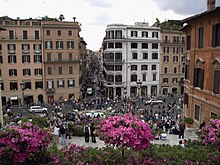
Via Condotti, Rome's main upscale shopping street. Seen from the top of the Spanish steps and Piazza di Spagna

A model on the catwalk during a 2004 open-air fashion show in Via Veneto.
Main article: Fashion in Rome
See also: Shopping areas and markets in Rome and Fashion in ancient Rome
Rome is widely recognised as a world fashion capital. Although not as important as Milan, Rome is the world's 4th most important center for fashion in the world, according to the 2009 Global Language Monitor after Milan, New York and Paris, and beating London.[82] Major luxury fashion houses and jewellery chains, such as Bulgari, Fendi,[83] Laura Biagiotti and Brioni (fashion), just to name a few, are headquartered or were founded in the city. Also, other major labels, such as Chanel, Prada, Dolce & Gabbana, Armani and Versace have luxury boutiques in Rome, primarily along its prestigious and upscale Via dei Condotti.[edit] Seven hills
Main article: Seven hills of Rome
The city is famous for its seven hills, east of the river Tiber: Aventine Hill (Aventinus), Caelian HillCaelius), Capitoline Hill (Capitolinus), Esquiline Hill (Esquilinus), Palatine Hill (Palatinus), Quirinal Hill (Quirinalis), Viminal Hill (Viminalis).[84] Of the seven hills of current Rome, five (Aventine, Caelian, Esquiline, Quirinal and Viminal hills) are populated with monuments, buildings, and parks. The Capitoline now hosts the Municipality of Rome, and the Palatine Hill is an archaeological area. All these hills have strong cultural legacies and have unique histories. There are also other hills in Rome, such as the Janiculum Hill, the Pincian Hill and the Vatican Hill, to name a few, but these do not count as part of the seven hills of the city. ([edit] Sports

Stadio Olimpico, one of the locations of the 1960 Summer Olympics.

The outside of the Stadio Olimpico, as it was prepared for the final of the 2008-2009 UEFA Champions League
Football or soccer is the most popular sport in Rome, as in the rest of the country. The city hosted the final games of the 1934 and 1990 FIFA World Cup. The latter took place in the Olympic Stadium, which is also the home stadium for local Serie A clubs A.S. Roma and S.S. Lazio, whose rivalry has become a staple of Roman sports culture. Footballers who play for these teams and are also born in the city tend to become especially popular, as has been the case with players such as Francesco Totti and Daniele De Rossi (both for A.S. Roma). Atletico Roma is a minor team that plays in First Division; its home stadium is Stadio Flaminio.
Rugby union is gaining wider acceptance. The Stadio Flaminio is the home stadium for the Italy national rugby union team, which has been playing in the Six Nations Championship since 2000, albeit with less than satisfactory performances, as they have never won the championship. Rome is home to local rugby teams, such as Unione Rugby Capitolina, Rugby Roma, and S.S. Lazio.
Every May, Rome hosts the ATP Masters Series tennis tournament on the clay courts of the Foro Italico. Cycling was popular in the post-WWII period, although its popularity has faded. Rome has hosted the final portion of the Giro d'Italia twice, in 1989 and 2000. Rome is also home to other sports teams, including basketball (Virtus Roma), volleyball (M. Roma Volley), handball or waterpolo.
[edit] Transportation
Main article: Transport in Rome

Rome-Fiumicino Airport in 2008 was the sixth busiest airport in Europe.
Due to its location in the centre of the Italian peninsula, Rome is a principal railway node for central Italy. Rome's main train station, Termini, is one of the biggest train stations in Europe and the most heavily used in Italy, with around 400 thousand travellers passing through every day. The second-largest station in the city, Roma Tiburtina, is currently being redeveloped as a high-speed rail terminus.[85]
Rome is served by three airports. The intercontinental Leonardo Da Vinci International Airport is Italy's chief airport and is commonly known as "Fiumicino Airport", as it is located within the nearby Comune of Fiumicino, south-west of Rome. The older Rome Ciampino Airport is a joint civilian and military airport. It is commonly referred to as "Ciampino Airport", as it is located beside Ciampino, south-east of Rome. A third airport, the Roma-Urbe Airport, is a small, low-traffic airport located about 6 km north of the city centre, which handles most helicopter and private flights.
The city suffers from traffic problems largely due to this radial street pattern, making it difficult for Romans to move easily from the vicinity of one of the radial roads to another without going into the historic centre or using the ring-road. These problems are not helped by the limited size of Rome's metro system when compared to other cities of similar size. In addition, Rome has only 21 taxis for every 10,000 inhabitants, far below other major European cities.[86] Chronic congestion caused by cars during the 1970s and 1980s led to restrictions being placed on vehicle access to the inner city-centre during the hours of daylight. Areas where these restriction apply are known as Limited Traffic Zones (Zona a Traffico Limitato (ZTL) inItalian). More recently, heavy night-time traffic in Trastevere and San Lorenzo has led to the creation of night-time ZTLs in those districts, and there are also plans to create another night-time ZTL in Testaccio.
A 2-line metro system called the Metropolitana operates in Rome. Construction on the first branch started in the 1930s. The line had been planned to quickly connect the main train stationWorld Fair was supposed to be held. The event never took place because of war. The area was later partly redesigned and renamed EUR (Esposizione Universale di Roma: Rome Universal Exhibition) in the 1950s to serve as a modern business district. The line was finally opened in 1955, and it is now part of the B Line. with the newly planned E42 area in the southern suburbs, where the 1942
The A line opened in 1980 from Ottaviano to Anagnina stations, later extended in stages (1999–2000) to Battistini. In the 1990s, an extension of the B line was opened from Termini to Rebibbia. This underground network is generally reliable (although it may become very congested at peak times and during events, especially the A line) as it is relatively short. As of 2005, its total length is 38 km (24 mi).
The two existing lines, A and B, intersect at Roma Termini station. A new branch of the B line (B1) is under construction with an estimated cost of €500 million. It is scheduled to open in 2012. B1 will connect to line B at Piazza Bologna and will have four stations over a distance of 3.9 km (2 mi). A third line, line C, is under construction with an estimated cost of €3 billion and will have 30 stations over a distance of 25.5 km (16 mi). It will partly replace the existing Rail Road line, Termini-Pantano. It will feature full automated, driverless trains.[87] The first section is due to open in 2011 and the final sections in 2015, but archaeological findings often delay underground construction work.
A fourth line, D line, is also planned. It will have 22 stations over a distance of 20 km (12 mi). The first section is projected to open in 2015 and the final sections before 2035.
Above-ground public transport in Rome is made up of a bus, tram and urban train network (FR lines). The bus and tram network is run by Trambus S.p.A. under the auspices of ATAC S.p.A.Azienda Tranvie ed Autobus del Comune in Italian). The bus network has in excess of 350 bus lines and over 8 thousand bus stops, whereas the more-limited tram system has 39 km of track and 192 stops.[88] There is also one trolleybus line, opened in 2005, and additional trolleybus lines are planned.[89] (which originally stood for the Bus and Tram Agency of the Commune,
[edit] International entities, organisations and involvement

FAO headquarters in Rome
Another body, the Sovereign Military Order of Malta (SMOM), took refuge in Rome in 1834, due to the conquest of Malta by Napoleon in 1798. It is sometimes classified as having sovereignty but does not claim any territory in Rome or anywhere else, hence leading to dispute over its actual sovereign status.
Rome is also the seat of international agencies of the United Nations, such as the World Food Programme (WFP), the Food and Agriculture Organization (FAO), and the International Fund for Agricultural Development (IFAD).
Rome has traditionally been involved in the process of European political integration. In 1957, the city hosted the signing of the Treaty of Rome, which established the European Economic Community (predecessor to the European Union), and also played host to the official signing of the proposed European Constitution in July 2004.
Rome is the seat of the NATO Defence College and is the place where the Statute of the International Criminal Court was formulated.
[edit] Twin towns, sister cities and partner cities
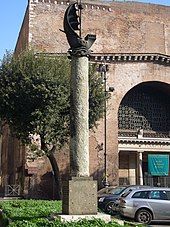
Column dedicated to Paris in 1956 near the Baths of Diocletian
 Paris, France
Paris, France
- (French) Seule Paris est digne de Rome; seule Rome est digne de Paris.
- (Italian) Solo Parigi è degna di Roma; solo Roma è degna di Parigi.
- "Only Paris is worthy of Rome; only Rome is worthy of Paris."[90][91][92]
[edit] See also
[edit] References
- ^ "Demography in Figures". Istituto nazionale di statistica (ISTAT). http://demo.istat.it/index_e.html. June 2010.
- ^ OECD (2006). "OECD Territorial Reviews: Competitive Cities in the Global Economy". p. 39. http://213.253.134.43/oecd/pdfs/browseit/0406041E.PDF. Retrieved 30 April 2009.
- ^ "Rome, city, Italy". Columbia Encyclopedia (6th ed.). 2009. http://www.questia.com/PM.qst?a=o&d=117042793.
- ^ a b Bremner, Caroline (12 December 2008). "Euromonitor International's Top City Destinations Ranking". Euromonitor International. http://www.euromonitor.com/_Euromonitor_Internationals_Top_City_Destinations_Ranking. Retrieved 2 March 2010.
- ^ a b "European city brands". City Mayors. 28 August 2008. http://www.citymayors.com/marketing/city-brands.html. Retrieved 14 June 2010.
- ^ a b "Historic Centre of Rome, the Properties of the Holy See in that City Enjoying Extraterritorial Rights and San Paolo Fuori le Mura". UNESCO World Heritage Center. http://whc.unesco.org/en/list/91. Retrieved 8 June 2008.
- ^ a b "Itv News | The 50 Most Visited Places in The World". Itvnews.tv. http://www.itvnews.tv/Blog/Blog/the-50-most-visited-places.html. Retrieved 17 October 2009.[dead link]
- ^ Claudio Rendina, Roma ieri, oggi, domani, Newton Compton, Roma, 2007, pg. 17
- ^ This hypothesis originates from the Roman Grammarian Maurus Servius Honoratus.
- ^ This hypothesis originates from Plutarch
- ^ Heiken, G., Funiciello, R. and De Rita, D. (2005), The Seven Hills of Rome: A Geological Tour of the Eternal City. Princeton University Press.
- ^ Livy, Ab Urbe Condita I, 7
- ^ "Rome: Pre-20th-Century History". Lonely Planet. http://www.lonelyplanet.com/worldguide/italy/rome/history. Retrieved 4 July 2008.
- ^ Wilford, John Nobel (12 June 2007). "More Clues in the Legend (or Is It Fact?) of Romulus". New York Times. http://www.nytimes.com/2007/06/12/science/12rome.html. Retrieved 11 August 2008.
- ^ Livy, Ab Urbe Condita V.
- ^ CosmoLearning. "Greco-Roman World - Greece (3650 BC-146 BC)". Cosmolearning.com. http://www.cosmolearning.com/topics/greece-3650-bc-146-bc/. Retrieved 3 February 2010.
- ^ a b "Augustus (63 BC - AD 14)". Historical Figures. British Broadcasting Company. http://www.bbc.co.uk/history/historic_figures/augustus.shtml. Retrieved 3 February 2010.
- ^ "Julius Caesar - Roman Dictator". h2g2. British Broadcasting Company. http://www.bbc.co.uk/dna/h2g2/A531767. Retrieved 3 February 2010.
- ^ "Pax Romana". Unrv.com. http://www.unrv.com/early-empire/pax-romana.php. Retrieved 3 February 2010.
- ^ "University of Chicago". Penelope.uchicago.edu. http://penelope.uchicago.edu/Thayer/E/Roman/Texts/secondary/journals/CJ/42/4/Nero_Fiddled*.html. Retrieved 3 February 2010.
- ^ Population crises and cycles in history. A review of the book Population Crises and Population cycles by Claire Russell and W.M.S. Russell.
- ^ Italian Peninsula, 500–1000 A.D., The Metropolitan Museum of Art
- ^ "Pope Alexander VI". Nndb.com. http://www.nndb.com/people/159/000092880/. Retrieved 3 February 2010.
- ^ work=Catholic Enclclopedia "Basilica of St. Peter". Newadvent.org. 1 February 1912. http://www.newadvent.org/cathen/13369b.htm work=Catholic Enclclopedia. Retrieved 3 February 2010.
- ^ a b c d e CTI, Guida d'Italia, Vol. IV, pg. 22
- ^ CTI, Guida d'Italia, Vol. IV, pg. 23
- ^ woth=Catholic Encyclopedia "Pope Pius IX". Newadvent.org. http://www.newadvent.org/cathen/12134b.htm woth=Catholic Encyclopedia. Retrieved 3 February 2010.
- ^ IMDb.com
- ^ "Candidate Cities for Future Olympic Games". Bladesplace.id.au. http://www.bladesplace.id.au/olympic-games-candidates.html. Retrieved 17 October 2009.
- ^ "The World According to GaWC 2008". Lboro.ac.uk. 3 June 2009. http://www.lboro.ac.uk/gawc/world2008t.html. Retrieved 3 February 2010.
- ^ "The 2008 Global Cities Index". Foreignpolicy.com. 15 October 2008. http://www.foreignpolicy.com/story/cms.php?story_id=4509. Retrieved 3 February 2010.
- ^ "Maxxi_Museo Nazionale Delle Arti Del Xxi Secolo". Maxxi.beniculturali.it. http://www.maxxi.beniculturali.it/english/. Retrieved 25 March 2010.
- ^ "Auditorium Parco della Musica". Auditorium.com. http://www.auditorium.com/. Retrieved 25 March 2010.
- ^ "ROME | Congress Center Italia EUR "Nuvola di Fuksas" (Fuksas)". SkyscraperCity. http://www.skyscrapercity.com/showthread.php?t=866754. Retrieved 25 March 2010.
- ^ a b ITVnews.tv[dead link]
- ^ Originally founded as circoscrizioni in 1972, they became municipi in 2001: "Territorio" (in Italian). Comune di Rome. http://www.comune.roma.it/was/wps/portal/!ut/p/_s.7_0_A/7_0_21L?menuPage=/Area_di_navigazione/Sezioni_del_portale/Dipartimenti_e_altri_uffici/Dipartimento_XV/www-9-romastatistica-9-it/Territorio/&flagSub=. Retrieved 5 October 2009.
- ^ "The "Rioni" of Rome". Romeartlover.it. http://www.romeartlover.it/Rioni.html. Retrieved 3 February 2010.
- ^ "University of Oregon". Nolli.uoregon.edu. 25 September 2006. http://nolli.uoregon.edu/rioni.html. Retrieved 3 February 2010.
- ^ Ravaglioli, Armando (1997) (in Italian). Roma anno 2750 ab Urbe condita. Rome: Tascabili Economici Newton. ISBN 888183670X.
- ^ "World Map of Köppen−Geiger Climate Classification". http://koeppen-geiger.vu-wien.ac.at/.
- ^ "Snow in Rome". London: guardian.co.uk. 12 February 2010. http://www.guardian.co.uk/weather/gallery/2010/feb/12/rome-europe. Retrieved 14 February 2010.
- ^ "Visualizzazione tabella CLINO della stazione / CLINO Averages Listed for the station Roma Ciampino". http://www.meteoam.it/modules.php?name=viewClinoFile&station=239&name_station=Roma%20Ciampino. Retrieved 16 June 2010.
- ^ "Visualizzazione tabella CLINO della stazione / CLINO Averages Listed for the station Roma Fiumicino". http://www.meteoam.it/modules.php?name=viewClinoFile&station=242&name_station=Roma%20Fiumicino. Retrieved 16 June 2010.
- ^ "Statistiche demografiche ISTAT". Demo.istat.it. http://demo.istat.it/bil2007/index.html. Retrieved 3 February 2010.
- ^ Rome Post - what's happening in Rome
- ^ Coarelli, p. 308.
- ^ "Green Areas". RomaPerKyoto.org. Archived from the original on 4 February 2008. http://web.archive.org/web/20080204030918/http://www.romaperkyoto.org/index.php?option=com_content&task=view&id=35&Itemid=52. Retrieved 9 November 2008.
- ^ Frontin, Les Aqueducs de la ville de Rome, translation and commentary by Pierre Grimal, Société d'édition Les Belles Lettres, Paris, 1944.
- ^ Italian Gardens, a Cultural History, Helen Attlee. Francis Lincoln Limited, London 2006.
- ^ "Chasing Obelisks in Rome". Initaly.com. http://www.initaly.com/regions/classic/obelisks.htm. Retrieved 3 February 2010.
- ^ "The Bridges of Ancient Rome". Citrag.it. http://www.citrag.it/archi/page/bridges/e_f_pn_ro.htm. Retrieved 3 February 2010.
- ^ "Sant'Angelo Bridge". Encyclopædia Britannica. http://www.britannica.com/EBchecked/topic/523159/SantAngelo-Bridge. Retrieved 3 February 2010.
- ^ a b c d "Rapporto Censis 2006". Censis.it. http://www.censis.it/277/372/5732/5766/5783/5784/content.asp. Retrieved 3 February 2010.
- ^ Observatoribarcelona.org[dead link]
- ^ a b "La classifica dei redditi nei comuni capoluogo di provincia". Il Sole 24 ORE. http://www.ilsole24ore.com/speciali/redditi_comuni_08/. Retrieved 14 June 2010.
- ^ "World's richest cities in 2009". City Mayors. 22 August 2009. http://www.citymayors.com/economics/richest_cities.html. Retrieved 14 June 2010.
- ^ DeCarlo, Scott (30 March 2006). "The World's 2000 Largest Public Companies". Forbes. http://www.forbes.com/2006/03/29/06f2k_worlds-largest-public-companies_land.html. Retrieved 16 January 2007.
- ^ Caroline Bremner (11 October 2007). "Top 150 City Destinations: London Leads the Way". Euromonitor International. http://www.euromonitor.com/Top_150_City_Destinations_London_Leads_the_Way. Retrieved 3 August 2008. This article has the complete list of 150 cities
- ^ "How the world views its cities" – The Anholt City Brands Index 2006[dead link]
- ^ "Roman Academies". Catholic Encyclopedia. Newadvent.org. 1 March 1907. http://www.newadvent.org/cathen/01083b.htm. Retrieved 3 February 2010.
- ^ Max Planck Gesellschaft e.V (17 May 2006). "Max Planck Society – Hanno and Ilse Hahn Prize". Mpg.de. http://www.mpg.de/english/aboutTheSociety/aboutUs/scientificAwards/awardsOfMPS/hannoIlseHahnPrize/index.html. Retrieved 25 January 2010.
- ^ Amedeo Benedetti, La Biblioteca della Società Geografica Italiana, "Biblioteche oggi", n. 3, aprile 2009, p. 41.
- ^ Vatican Film Library informational pamphlet
- ^ Arwu.org[dead link]
- ^ Arwu.org[dead link]
- ^ Nella sede romana sono presenti le facoltà di medicina e di economia.
- ^ "About the NAC". Pontifical North American College. http://www.pnac.org/about-us/about-the-nac/. Retrieved 1 October 2010.
- ^ Activitaly.it (Italian)
- ^ "AIRC-HC Program in Archaeology, Classics, and Mediterranean Culture". Romanculture.org. http://www.romanculture.org/index.php?page=airc-hc-rome-program-in-archaeology-and-classical-studies. Retrieved 3 February 2010.
- ^ "Isvroma.it". Isvroma.it. Archived from the original on 8 July 2008. http://web.archive.org/web/20080708234610/http://www.isvroma.it/public/EN/index.php?option=com_content&task=view&id=13&Itemid=+. Retrieved 3 February 2010.
- ^ James E. Packer (January/February 1998). "Trajan's Glorious Forum". Archaeology (Archaeological Institute of America) 51 (1). http://www.archaeology.org/9801/abstracts/trajan.html. Retrieved 2 October 2010.
- ^ I H Evans (reviser), Brewer's Dictionary of Phrase and Fable (Centenary edition Fourth impression (corrected); London: Cassell, 1975), page 1163
- ^ Francis Trevelyan Miller, Woodrow Wilson, William Howard Taft, Theodore Roosevelt. America, the Land We Love (1915), page 201 Google Books Search
- ^ Toynbee, J. M. C. (December 1971). "Roman Art". The Classical Review 21 (3): 439–442. doi:10.1017/S0009840X00221331. http://links.jstor.org/sici?sici=0009-840X%28197112%292%3A21%3A3%3C439%3ARA%3E2.0.CO%3B2-O. Retrieved 11 December 2007.
- ^ "Baroque Art of Rome (ROME 211)". Trincoll.edu. http://www.trincoll.edu/depts/rome/curriculum/rome211.html. Retrieved 3 February 2010.
- ^ Matt Rosenberg. "Grand Tour of Europe: The Travels of 17th & 18th Century Twenty-Somethings". About.com. http://geography.about.com/od/historyofgeography/a/grandtour.htm. Retrieved 3 February 2010.
- ^ "The Franca Camiz Memorial Field Seminar in Art History". Trinity College, Hartford Connecticlt. Archived from the original on 30 May 2008. http://web.archive.org/web/20080530094628/http://www.trincoll.edu/depts/rome/curriculum/rome350.html. Retrieved 3 February 2010.
- ^ (Rolland 2006, p. 273).
- ^ Piras, 291.
- ^ "history of Cinecittà Studios in Rome". Romefile.com. http://www.romefile.com/culture/cinecitta.php. Retrieved 17 October 2009.
- ^ Ostler, N. (2007), Ad Infinitum: A Biography of Latin. London: HarperCollins
- ^ "The Global Language Monitor » Fashion". Languagemonitor.com. 20 July 2009. http://www.languagemonitor.com/popular-culture/fashion. Retrieved 17 October 2009.
- ^ "Error: no
|title=specified when using {{Cite web}}". Fendi. http://www.fendi.com/. Retrieved 17 October 2009. - ^ "The Seven Hills of Rome". Musesrealm.net. http://www.musesrealm.net/rome/sevenhills.html. Retrieved 25 January 2010.
- ^ — Entry on Roma Tiburtina station on the official website of the Italian high-speed rail service (Italian)
- ^ Kiefer, Peter (30 November 2007). "Central Rome Streets Blocked by Taxi Drivers". New York Times. http://www.nytimes.com/2007/11/30/world/europe/30rome.html?scp=93&sq=Rome&st=nyt. Retrieved 10 February 2008.
- ^ Kington, Tom (14 May 2007). "Roman remains threaten metro". Guardian (London). http://www.guardian.co.uk/world/2007/may/14/italy.artnews. Retrieved 10 August 2008.
- ^ The figures are from the ATAC website (Italian).
- ^ Webb, Mary (ed.) (2009). Jane's Urban Transport Systems 2009–2010, p. 195. Coulsdon (UK): Jane's Information Group. ISBN 978-0-7106-2903-6.
- ^ "Twinning with Rome". http://www.paris.fr/portail/english/Portal.lut?page_id=8139&document_type_id=5&document_id=29903&portlet_id=18784. Retrieved 27 May 2010.
- ^ "Les pactes d'amitié et de coopération". Mairie de Paris. http://www.paris.fr/portail/accueil/Portal.lut?page_id=6587&document_type_id=5&document_id=16468&portlet_id=14974. Retrieved 14 October 2007.
- ^ "International relations: special partners". Mairie de Paris. http://www.paris.fr/en/city_government/international/special_partners.asp. Retrieved 14 October 2007.[dead link]
- ^ "Sister Cities". Beijing Municipal Government. http://www.ebeijing.gov.cn/Sister_Cities/Sister_City/. Retrieved 23 June 2009.
- ^ "Le jumelage avec Rome" (in French). Municipalité de Paris. http://www.paris.fr/portail/accueil/Portal.lut?page_id=6587&document_type_id=5&document_id=16467&portlet_id=14974. Retrieved 9 July 2008.
- ^ Madrid city council webpage "Mapa Mundi de las ciudades hermanadas". Ayuntamiento de Madrid. http://www.munimadrid.es/portal/site/munimadrid/menuitem.dbd5147a4ba1b0aa7d245f019fc08a0c/?vgnextoid=4e84399a03003110VgnVCM2000000c205a0aRCRD&vgnextchannel=4e98823d3a37a010VgnVCM100000d90ca8c0RCRD&vgnextfmt=especial1&idContenido=1da69a4192b5b010VgnVCM100000d90ca8c0RCRD Madrid city council webpage. Retrieved 17 October 2009.
- ^ "NYC's Sister Cities". Sister City Program of the City of New York. 2006. http://www.nyc.gov/html/unccp/scp/html/sc/main.shtml. Retrieved 1 September 2008.
- ^ "Twinning Cities: International Relations" (PDF). Municipality of Tirana. www.tirana.gov.al. http://www.tirana.gov.al/common/images/International%20Relations.pdf. Retrieved 23 June 2009.
- ^ Twinning Cities: International Relations. Municipality of Tirana. www.tirana.gov.al. Retrieved on 2008-01-25.
- ^ "Cooperation Internationale" (in French). © 2003–2009 City of Tunis Portal. http://www.commune-tunis.gov.tn/fr/mairie_cooperation1.htm. Retrieved 31 July 2009.[dead link]
- ^ "Rome and Multan ‘to be made sister cities’". Thenews.com.pk. 5 November 2008. http://www.thenews.com.pk/daily_detail.asp?id=145013. Retrieved 17 October 2009.[dead link]
[edit] Bibliography
- Rendina, Mario (2007) (in Italian). Roma ieri, oggi, domani. Rome: Newton & Compton Editori.
- Lucentini, Mario (2002) (in Italian). La Grande Guida di Roma. Rome: Newton & Compton Editori. ISBN 88-8289-053-8.
- Spoto, Salvatore (1999) (in Italian). Roma Esoterica. Rome: Newton & Compton Editori. ISBN 88-8289-265-4.
- Richard Brilliant (2006). Roman Art. An American's View. Rome: Di Renzo Editore. ISBN 88-8323-085-X.
- Rome. DK. 2006. ISBN 1405310901.
- Coarelli, Filippo (1984) (in Italian). Guida archeologica di Roma. Milano: Arnoldo Mondadori Editore.
- Bertarelli, Luigi Vittorio (1925) (in Italian). Guida d'Italia. IV. Rome: CTI.
[edit] Documentaries
- The Holy Cities: Rome produced by Danae Film Production, distributed by HDH Communications; 2006.
[edit] External links
| Find more about Rome on Wikipedia's sister projects: | |
| Definitions from Wiktionary | |
| Textbooks from Wikibooks | |
| Quotations from Wikiquote | |
| Source texts from Wikisource | |
| Images and media from Commons | |
| News stories from Wikinews | |
| Learning resources from Wikiversity | |
- Rome travel guide from Wikitravel
- Rome travel guides at the Open Directory Project
- City models of Ancient Rome
- Vintage Rome: The Eternal City – slideshow by Life magazine
- Official
- Official site of the City of Rome (Italian)
- APT (official Tourist Office) of the City of Rome (English)
- Rome Museums — Official site (Italian)
- Vatican Museums (English)
- Capitoline Museums (English)
| | ||
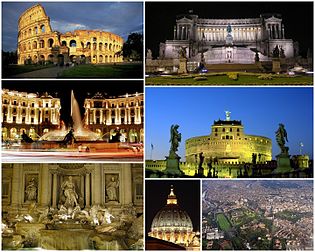









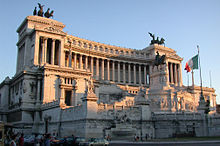






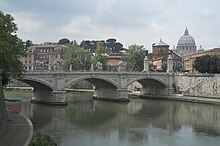










No comments:
Post a Comment